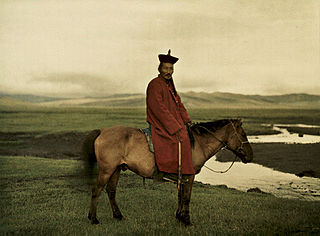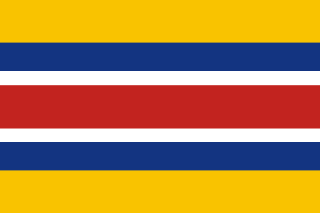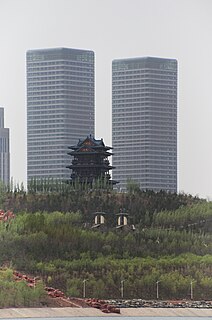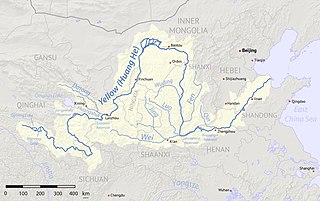External links
| This government-related article is a stub. You can help Wikipedia by expanding it. |
The Southern Mongolian Democratic Alliance was created in May 1992, by Hada and other Mongol activists including Tegexi. Its major goal is the self-determination of Inner Mongolia (an autonomous region of China).
In the 1980s, Temtselt Shobshuud (Chinese :Xi Haiming), Huchuntegus (Chinese :Hu Qing Te Gu Si), Wang Manglai (Chinese :Wang Man Lai) and Hada, all students at universities in Hohhot, discussed establishment of the Inner Mongolian People's Party (IMPP), a political party for Mongolians in Inner Mongolia. Later, individuals from eastern and western Inner Mongolia divided and therefore, Huchuntegus established the Ordos Association of Ethnic Culture at the Ikh Juu League (now the Ordos City). Hada established the Southern Mongolian Democratic Alliance. Xi Haiming fled his country and established the IMPP in New York, in March, 1997. [1]
The Southern Mongolian Democratic Alliance organization was originally named "Mongolian Culture Rescue Committee" and Hada was elected chairman. In 1994, this group created a journal: Voice of Southern Mongolia, and in 1995 initiated a constitution outlining the Alliance's main mission as “opposing colonization by the Han people and striving for self-determination, freedom and democracy in Southern [Inner] Mongolia.” Voice of Southern Mongolia, was banned in 1995, and it is still banned nowadays. [2]
| This government-related article is a stub. You can help Wikipedia by expanding it. |

The Mongols are an East Asian ethnic group native to Mongolia and to China's Inner Mongolia Autonomous Region. They also live as minorities in other regions of China, as well as in Russia. Mongolian people belonging to the Buryat and Kalmyk subgroups live predominantly in the Russian federal subjects of Buryatia and Kalmykia.

Inner Mongolia or Nei Mongol, officially the Inner Mongolia Autonomous Region, is a landlocked and Mongolic autonomous region of the People's Republic of China. Its border includes most of the length of China's border with the country of Mongolia. The rest of the Sino–Mongolian border coincides with part of the international border of the Xinjiang autonomous region and the entirety of the international border of Gansu province. Inner Mongolia also accounts for a small section of China's border with Russia. Its capital is Hohhot; other major cities include Baotou, Chifeng, Tongliao and Ordos.

Shaanxi is a landlocked province of the People's Republic of China. Officially part of Northwest China, it borders the province-level divisions of Shanxi, Henan (E), Hubei (SE), Chongqing (S), Sichuan (SW), Gansu (W), Ningxia (NW) and Inner Mongolia (N).

Mengjiang (Mengkiang), also known in English as Mongol Border Land or the Mongol United Autonomous Government, was an autonomous area in Inner Mongolia, formed in 1939 as a puppet state of the Empire of Japan, then from 1940 being under the nominal sovereignty of the Reorganized National Government of the Republic of China. It consisted of the previously Chinese provinces of Chahar and Suiyuan, corresponding to the central part of modern Inner Mongolia. It has also been called Mongukuo or Mengguguo. The capital was Kalgan, from where it was ruled by the Mongol nobleman Prince Demchugdongrub. The territory returned to Chinese control after the defeat of the Japanese Empire in 1945.

Hohhot, abbreviated Hushi, formerly known as Kweisui, is the capital of Inner Mongolia in the north of the People's Republic of China, serving as the region's administrative, economic and cultural center. Its population was 2,866,615 inhabitants as of the 2010 census, of whom 1,980,774 lived in the built-up area made up of 4 urban districts.

The Monguor, the Tu people, the White Mongol or the Tsagaan Mongol, are one of the 56 officially recognized ethnic groups in China. The "Tu" ethnic category was created in the 1950s.

The Inner Mongolian People's Party, or IMPP, is an Inner Mongolian secessionist movement. The party was started in 1997 in Princeton, New Jersey. Citing the abuses of the Chinese government against Mongols during the Cultural Revolution, the goal of the party is to establish an independent state of Inner Mongolia; the potential for unification with the existent nation of Mongolia is beyond the current scope of party goals.

Ordos is one of the twelve major subdivisions of Inner Mongolia, China. It lies within the Ordos Plateau of the Yellow River. Although mainly rural, Ordos is administered as a prefecture-level city.

The Zhukaigou culture was a late Neolithic and early Bronze Age culture centered in the Ordos Plateau of Inner Mongolia, China. The type site at Zhukaigou was discovered in Ejin Horo Banner, Inner Mongolia, and excavated from 1977 to 1984. Zhukaigou culture is a reputed progenitor of the Ordos bronze culture and accordingly a first "Northern Zone" culture, extending to northern and central Inner Mongolia, northern Shaanxi, and northern Shanxi, with the Ordos region at its center. Transition to metalworking is dated to around the end of the third millennium BCE, at the same time was attained a higher level in the ceramic. Zhukaigou culture lasted to c. 1500 BCE.

Alxa League or Ālāshàn League is one of 12 prefecture level divisions and 3 extant leagues of Inner Mongolia. The league borders Mongolia to the north, Bayan Nur to the northeast, Wuhai and Ordos to the east, Ningxia to the southeast, and Gansu to the south and west. The capital is Bayanhot Town, formerly known as Dingyuanying (定远营镇) or Wang Ye Fu, in the aimag's Left Banner. The Mongolian variety spoken in this area is the Alasha dialect.
Hada is an ethnic Mongol activist, who has campaigned for self-determination of Southern Mongolia. He was detained for 15 years in prison in Chifeng. He was released from prison on December 10, 2010, but still detained in an detention centre in Inner Mongolia. In December 2014 he was released from detention.
Various nomadic empires, including the Xiongnu, the Xianbei state, the Rouran Khaganate (330–555), the First 552–603) and Second Turkic Khaganates (682–744) and others, ruled the area of present-day Mongolia. The Khitan people, who used a para-Mongolic language, founded an empire known as the Liao dynasty (916–1125) and ruled Mongolia and portions of the present-day Russian Far East, northern Korea, and North China.

The Ordos Plateau, also known as the Ordos Basin or simply the Ordos, is a highland sedimentary basin in northwest China with an elevation of 1,000–1,600 m (3,300–5,200 ft), and consisting mostly of land enclosed by the Ordos Loop, a large northerly rectangular bend of the Yellow River that makes up the river's entire middle section. It is China's second largest sedimentary basin with a total area of 370,000 km2 (140,000 sq mi), and includes territories from five provinces, namely Shaanxi, Gansu, Ningxia, Inner Mongolia and a thin fringe of Shanxi, but is demographically dominated by the former three, hence is also called the Shaan-Gan-Ning Basin. The basin is bounded in the east by the Lüliang Mountains, north by the Yin Mountains, west by the Helan Mountains, and south by the Huanglong Mountains, Meridian Ridge and Liupan Mountains.
Govruud Huuchinhuu was a dissident writer and human rights-activist from Inner Mongolia. In January 2011, Huuchinhuu disappeared after leaving a Tongliao hospital in Inner Mongolia. After 2 years of enforced disappearance by the Chinese government, she was placed under house arrest. She died of cancer on 25 October 2016, still under round-the-clock monitoring until her last breath.

Religion in Inner Mongolia is characterised by the diverse traditions of Mongolian-Tibetan Buddhism, Chinese Buddhism, the Chinese traditional religion including the traditional Chinese ancestral religion, Taoism, Confucianism and folk religious sects, and the Mongolian native religion. The region is inhabited by a majority of Han Chinese and a substantial minority of Southern Mongols, so that some religions follow ethnic lines.

The Inner Mongolian independence movement, also known as the Southern Mongolian independence movement, is a movement for the independence of Inner Mongolia and the political separation of Inner Mongolia from the People's Republic of China. It is principally led by the Mongolian diaspora in countries like Japan and the United States, and in some European countries.

Temtsiltu Shobtsood or Temtselt Shobshuud, also known as his Chinese name Xi Haiming, is an ethnic Mongol activist who campaign for independence of "Southern Mongolia". Now he is the chairman of Inner Mongolian People's Party.
Yanmen Commandery was an administrative subdivision (jùn) of the state of Zhao established c. 300 BC and of northern imperial Chinese dynasties until AD 758. It occupied lands in what is now Shanxi and Inner Mongolia. Its first seat was at Shanwu ; its later seats moved southeast to the more defensible sites at Yinguan and Guangwu.

Secession in China refers to several secessionist movements in the People's Republic of China.

The 2020 Inner Mongolia protests is a protest caused by a curriculum reform imposed on ethnic schools by the China's Inner Mongolia Department of Education. The two-part reform replace Mongolian as the medium of instruction by Standard Mandarin in three specified subjects and replace three regional textbooks, printed in Mongolian script, by the nationally-unified textbook series edited by the Ministry of Education, written in Standard Mandarin. On a broader scale, the opposition to the curriculum change reflects ethnic issues in China and the decline of regional language education in China.